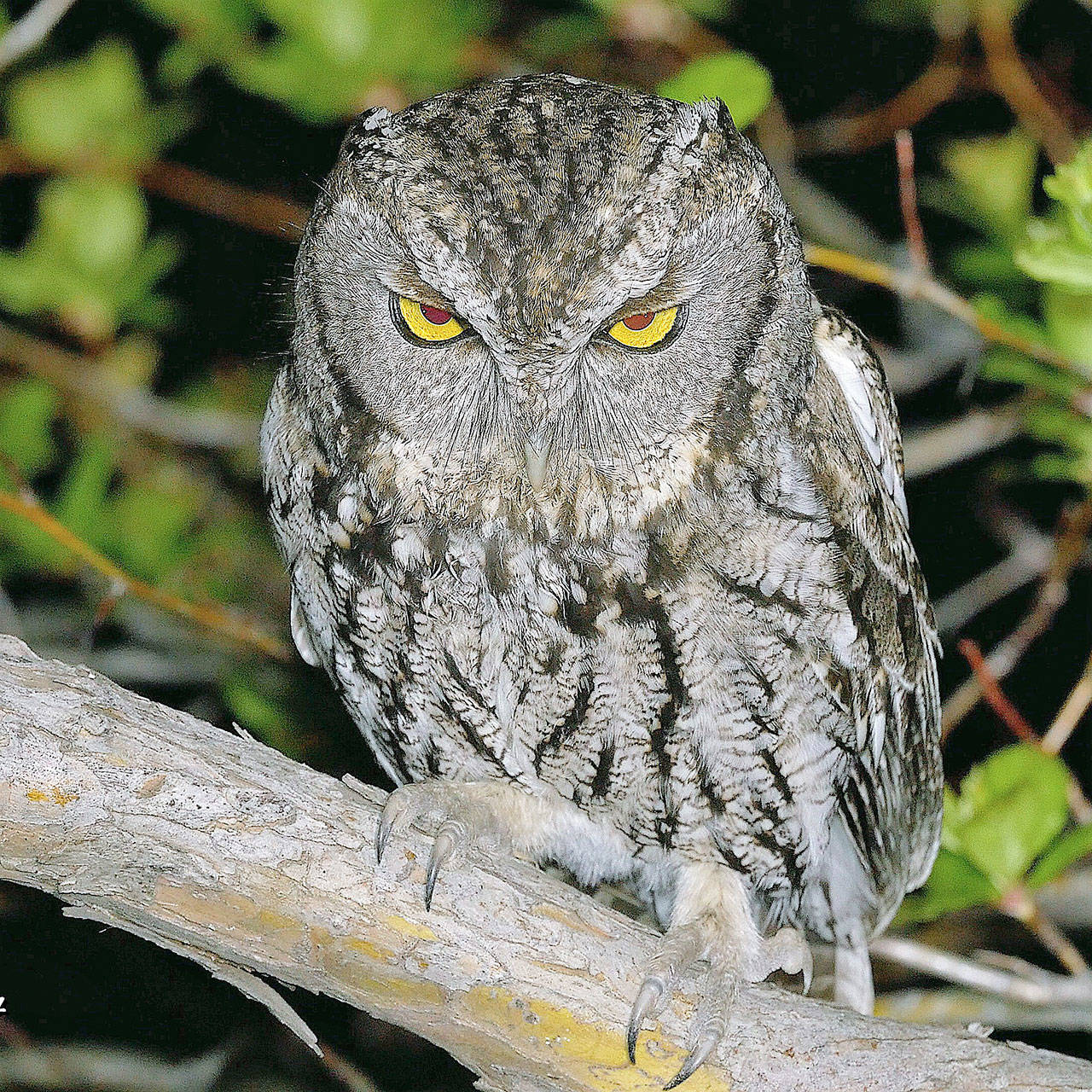By Dianna Moore
Grays Harbor Audubon Society
I have waited a long time to write about this owl; it has a special place in my heart as the first owl to visit my yard after I moved to the Pacific NW. It is disappointing to report I have not seen one since then! It is one of the birds that is under attack, literally, from the larger, invasive Barred Owl. So when Dan Reiff sent me this photo, I was pretty excited. I hope you are too. I highly recommend listening to it’s call so you can I.D. the owl by sound. https://www.allaboutbirds.org/guide/Western_Screech-Owl/sounds
General description: Western Screech Owls are smaller than both the Barred Owl and the Great Horned Owl, the other two more common owls on the Harbor. They are approximately the size of a pair of binoculars, or 7.5 to 9.8 inches in length, with a wingspan of 21.7 to 24.4 inches, and weigh from 3.5 to 10.8 ounces. Their coloring is streaked gray and gray-brown, darker in western Washington than eastern, with big yellow eyes, and ear tufts which may or may not be raised.
Habitat: More common to mixed evergreen and deciduous forests, often along streams, they can also be readily found in parks and yards, cemeteries, deserts, and suburban areas. They tend to avoid dense forest. They can be seen anywhere from the coast up to 6,000 foot elevation, but are more likely to be found in deciduous trees, such as cottonwood, alder, aspen, oak, and bigleaf maple along streambeds.
Behavior: Western Screech Owls are mostly nocturnal, although the western birds can be seen out and about on cloudy days. For their size they are pretty aggressive, and will often take prey that is larger and outweighs them, especially if feeding young. When threatened, they slick down their feathers, stand tall, elevate their ear tufts, and draw the feathers around their beaks forward. This allows them to “disappear” against the background of the tree in which they are perched.
Diet: Like most raptors, these owls are sit-and-wait predators perching inconspicuously on tree branches and watching the ground for prey. They are carnivores and eat pocket mice, deermice, grasshopper mice, shrews, woodrats, kangaroo rats, as well as bats and occasionally rabbits. They also eat small birds, insects, crayfish, worms, slugs, snails, and whip scorpions.
Nesting: Western Screech Owls form long-term, monogamous pair bonds. They use already excavated holes in a tree or are perfectly fine with a human-provided nestbox. The male owl finds a suitable hole, then calls or leads the female to it, sometimes by carrying an enticing prey item. They may use the same cavity for several years in a row. They don’t add to whatever is on the floor of the nestbox, but use what is available. The female incubates three to five eggs for 33 to 35 days while the male brings her food. Once the young hatch, she broods them for about three weeks while the male continues to provide food for his family. The young leave the nest and begin branching (climbing around on nearby branches) at about seven to 10 days later. They stay close to the nest for a few more days while developing their flying skills, then remain nearby for care and feeding until more proficient at flying skills, about five weeks.
Migration: Western Screech Owls stay on their territory year round and do not migrate.
Conservation status: Due to their secretive nature it is hard to survey these owls. We know they lack suitable nest cavities, and more of their habitat is falling to urban development. It is also thought that the increasing population of Barred Owls and their preying on the smaller screech owl may also be a cause for concern. Despite their ability to get by in populated areas, they still need some help with properly situated nesting locations. We have found most readily accept nest-boxes in yards. So if the desire to help these birds overcomes your lack of construction experience, we have just the set of instructions to help you build an awesome nestbox. https://nestwatch.org/wp-content/themes/nestwatch/birdhouses/western-screech-owl.pdf
Where and when to find on Grays Harbor: Although listed as “uncommon” along the coast, these owls can still be found. The best way is to play a bit of their call, then listen for a reply. As mentioned earlier, try to look along streambeds with a good mix of deciduous trees, or in a nearby open space such as a park or a cemetery. Or build a nestbox and cross your fingers they find it acceptable. Good luck!.


